Master of the Playing Cards
Illustrations

The Veil of Veronica (Sudarium)
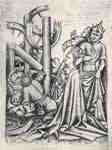
The Martyrdom of St. Catherine
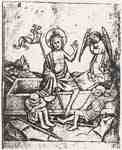
Sequence for "Passion of Christ"
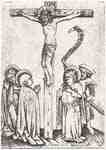
Sequence for "Passion of Christ"

Sequence for "Passion of Christ"
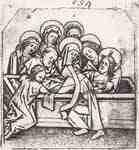
Sequence for "Passion of Christ"
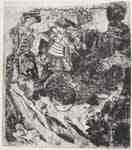



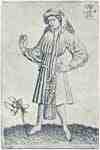
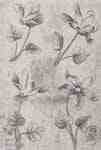
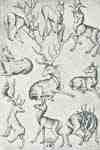






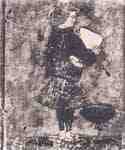
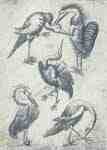
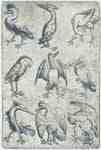
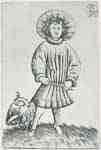

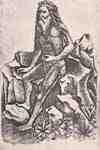

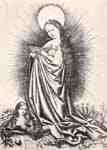

The Master of the Playing Cards was the first major master in the history of printmaking. He was a German (or conceivably Swiss) engraver, and probably also a painter, active in southwestern Germany from the 1430s to the 1450s, who has been called "the first personality in the history of engraving."[1] Various attempts to identify him have not been generally accepted, so he remains known only through his 106 engravings, which include the set of playing cards in five suits from which he takes his name. The majority of the set survives in unique impressions, most of which are in the Kupferstichkabinett, Dresden and the Bibliothèque nationale de France in Paris.[1] A further eighty-eight engravings are regarded as sufficiently close to his style to be by his pupils.[2]
Style
It has long been recognised that his style was closely related to that of paintings from south-western Germany and Switzerland in the period 1430-50, by artists of whom the best known is Konrad Witz. In addition the Alpine cyclamen very frequently appears in the engravings. Although an identification proposed by Leo Baer of him with Witz has not been accepted, he does appear to have been trained as an artist rather than a goldsmith like many early engravers. His prints show an engraving technique closely related to drawing, with forms conceived in three dimensions and delicately modeled; engravers trained as goldsmiths, such as Master E. S. or Israhel van Meckenem, have a different set of stylistic conventions.[1] His shading is mostly parallel vertical lines, and cross-hatching is rare.[3]
Apart from comparisons with paintings, the start of his period of activity can only be dated to before 1446 by a dated print by his presumed pupil the Master of 1446. The fact that he had a mature pupil suggests that he himself had been active for many years by that date.[3]
Prints by the Master very rarely come on the market, but on 20 September 2006 Christie's London auctioned an impression of the Queen of Flowers for £243,200 (about $450,000).
Cards
The 9 of Beasts from the playing cards. The central climbing bear also appears in an illuminated copy of the Gutenberg Bible. This is a "multiple-plate card", where each animal is on a separate little copper plate, several of which are reused on other cards.[1]
Many of his engravings, especially the cards, contain compositional elements that also occur in the miniatures of the Giant Bible of Mainz of 1452-3 and other illuminations made in Mainz between then and 1482, including at least one illuminated copy of the Gutenberg Bible, the copy now in Princeton University library. It has been suggested that he painted elements of these miniatures.[1] It is generally thought that both sets derive from a common manuscript model-book of the sort painters are known to have maintained, though this does not rule out his involvement, or that of his workshop, in the painting.[4] There are similar repetitions in many other manuscripts and other works of art, mostly but not all German.[5]
The cards have typical suits for Northern European cards of the period: flowers, birds, deer, beasts of prey and wild men - so five suits in total. Each symbol (or "pip") on a card is different, so the quantity and difficulty of the engraving is far greater than with a modern set (and, equally, rapid play must have been very difficult as there are no numbers). Engraved sets of cards are few; they must have been much more expensive than those made in woodcut, which can be printed in much greater numbers before the matrix wears out. Interestingly and unusually, some of the cards are composed of different little plates, one per pip, which were presumably held together in a frame for printing. Possibly the Master was in Mainz and was influenced by Johannes Gutenberg's movable type.[4] Despite this the majority of the pips are unique, and although they appear rather jumbled as groups, individually many are very fine studies of their subjects.[6] Despite the very few impressions surviving, some cards exist in two states, and some in different versions, all catalogued by Lehrs.
Place in printmaking
Martyrdom of St Sebastian
Woodcut old master prints had begun around the turn of the century, and were extremely popular by the start of the Master of the Playing Cards' career, but were then almost all very crudely executed. Playing cards and religious images were the vast majority of the production. Although he comes very early in the history of engraving for prints, the Master of the Playing Cards is certainly not the inventor of the technique, but he is the first significant artist to use either printmaking technique. Arthur Mayger Hind characterises his style as "incisive and individual".[7] After him come a series of other significant engravers with a training as either an artist or a goldsmith, and after woodcuts became used for illustrating printed books their quality also improved. The Master's other works are mostly religious and some are relatively large for very early engravings; these were intended mainly for insertion as illustrations into manuscript devotional books. As with most early printmakers, many of his designs survive only in copies by others, and many have doubtless not survived at all.
Some of his presumed pupils have been given names, such as the Master of the Nuremberg Passion, the Master of 1446, and the Master of the Banderoles.[3] If the Master also practiced as a painter, whether on panel or in manuscript illuminations, no identification of any of his works has been generally accepted.
References
Alan Shestack; Fifteenth century Engravings of Northern Europe;1967, National Gallery of Art, Washington (Catalogue), LOC 67-29080
Lehrs, Max. Geschichte und kritischer Katalog des deutschen, niederländischen und französischen Kupferstichs im XV. Jahrhundert (Vienna: Gesellschaft für vervielfältigende Kunst, 1908-1934): vol. I, pp. 63-207
A History of Engraving and Etching, Arthur M. Hind,p 20-21, Houghton Mifflin Co. 1923 (in USA), reprinted Dover Publications, 1963 ISBN 0-486-20954-7
A Hyatt Mayor, Prints and People, Metropolitan Museum of Art/Princeton, 1971, nos 115-117.ISBN 0691003262
Anne H. van Buren, Sheila Edmunds: Playing Cards and Manuscripts: Some Widely Disseminated Fifteenth Century Model Sheets, In: The Art Bulletin 56. March 1974, p.12-30, ISSN 0004-3079
See Van Buren & Edmunds op cit for a table
Hind, Arthur M. A History of Engraving & Etching From the 15th Century to the Year 1914. Dover Publications. p. 21. ISBN 9780486209548. Retrieved 3 July 2014.
Literature
NB: Twenty-nine of the cards, and other prints, are illustrated on Commons at [1]
Max Geisberg: Das älteste gestochene deutsche Kartenspiel vom Meister der Spielkarten, Studien zur deutschen Kunstgeschichte, Heitz, Straßburg 1905 - The standard work on the cards, in which all are reproduced.
Dorothy Miner, The Great Bible of Mainz, 500th Anniversary, Washington 1952
Hellmut Lehmann-Haupt, Gutenberg and the Master of the Playing Cards, 1966 (Yale)
Martha Anne Wood Wolff: The Master of the playing cards: an early engraver and his relationship to traditional media, 1979, Dissertation, Yale; UMI (ProQuest), Dissertation Services, 2002
Martha Wolff: Some Manuscript Sources for the Playing Card Master's Number Cards, In: The Art Bulletin 64, Dec. 1982, p.587-600, ISSN 0004-3079
External links
More images
Two cards from The Museum of Fine Arts, Boston. "The Queen of Stags" by the Master of the Playing Cards, and "Five of Flowers" by a student of the Master of Playing cards
Schoyen collection - a Book of Hours with border decorations including motifs from the cards - MS 007
----
Fine Art Prints | Greeting Cards | Phone Cases | Lifestyle | Face Masks | Men's , Women' Apparel | Home Decor | jigsaw puzzles | Notebooks | Tapestries | ...
----
Artist
A - B - C - D - E - F - G - H - I - J - K - L - M -
N - O - P - Q - R - S - T - U - V - W - X - Y - Z
Retrieved from "http://en.wikipedia.org/"
All text is available under the terms of the GNU Free Documentation License


